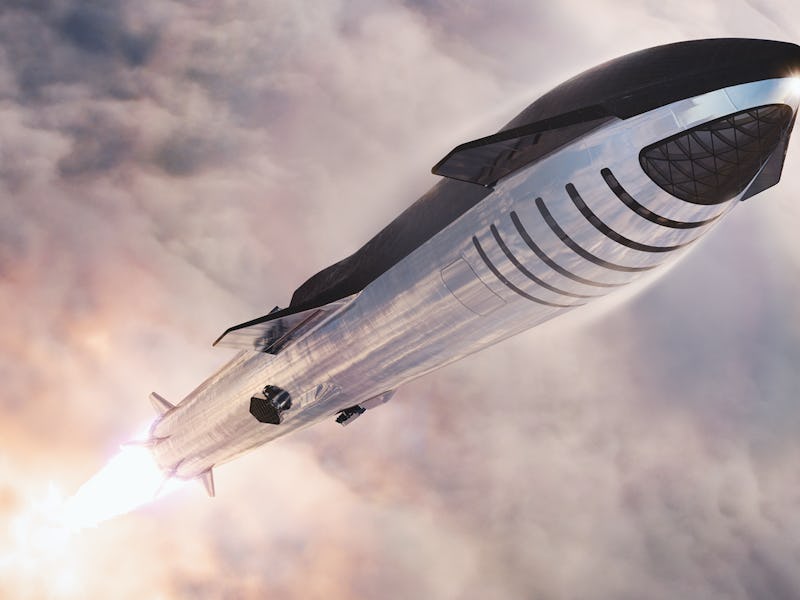SpaceX Starship: Elon Musk responds to fan render of Super Heavy flight
SpaceX is expected to launch its Super Heavy booster for the first time.

The Starship, SpaceX's giant rocket designed to ferry humans to Mars and beyond, is about to pass its next milestone.
On Wednesday, CEO Elon Musk explained on Twitter that the company has big plans for its Super Heavy booster tests. The booster pairs with the Starship to help the vehicle leave Earth. While early Starship flights have seen prototypes launch up and land on a pad, Musk wrote the team plans to "catch" the Super Heavy "with the launch tower arm, using the grid fins to take the load."
Musk's post encouraged artistic fans to try and visualize the upcoming feat — and the results are stunning.
Want to dive deeper on where Starship is going next? Subscribe to MUSK READS+ for exclusive interviews and analysis about all things Musk. You have LESS THAN 24 HOURS to make the most of our 2020 sale. Members receive instant access to our ever-expanding archive, including deep dives on SpaceX rival Rocket Lab and Hyperloop’s start date, plus future issues directly to your inbox twice per week. Don’t miss out — our annual subscriptions are 50% OFF until the end of the year.
The launch will be a landmark event in SpaceX history. Musk first unveiled the predecessor to the Starship, known as the BFR, back in September 2017. It's designed to transport over 150 tons or 100 people into space at a time. The fully-reusable ship can replace current SpaceX rockets like Falcon 9 and Falcon Heavy. Its use of liquid oxygen and methane as fuel means astronauts can fly to Mars, refuel using the planet's resources, and fly home or venture out further.
In other words, the Starship could be the vehicle that enables Musk's vision to transform humanity into a "multi-planetary species."
The Starship's tests have helped refine the rocket. SpaceX launched a prototype of the ship, which measures 160 feet tall and 30 feet diameter, to a height of 41,000 feet earlier this month — only to explode on landing. The prototype used three Raptor engines, but the final ship is expected to use six. The Super Heavy booster uses a further 28 engines and brings the total height to around 400 feet.
Musk's comments suggest that, beyond sheer size, the Super Heavy flight will be visually spectacular due to its imaginative catching system. YouTube user "smallstars," collaborating with Sweden-based artist Erik Corshammar, produced a video Thursday that aimed to imagine such a catching system in action. This visualization was described by "smallstars" as "my favorite so far":
The video caught the attention of Musk, who has a habit of responding to fan videos.
"Rocket motion is primarily vertical, so you want the top open," Musk wrote.
The comments appear to reference how, in the fan render, the top of the tower is covered by cables and support structures. Corshammar suggested an updated version in response:
The plan also drew question from SpaceX fans, who were surprised at the ambitious plan. One user called "flcnhvy" asked if Musk was playing a real-life version of Kerbal Space Program.
Musk responded that the idea has a lot of value. It would save on the mass and cost of legs, and means the team could immediately reposition the booster onto the launch mount. That would enable the ship to refly in under an hour, which could help dramatically increase access to space.
As for when we'll see the launch? Expect it in "a few months." From there, Musk is planning a crewed trip to Mars for the mid-2020s, as a precursor to a full-size city by 2050.
The Inverse analysis — The Starship has changed a lot in its development — it wasn't called Starship, for a start. While the plan sounds visually stunning, it's entirely possible SpaceX uses a different method for the final ship.
It wouldn't be the first time that Musk had outlined an ambitious plan, only to walk it back. In April 2018, Musk wrote that the firm would try to recover the upper stage of its rockets using "a giant party balloon." In November, Musk wrote that SpaceX was "no longer planning to upgrade Falcon 9 second stage for reusability," instead focusing efforts on Starship.
Indeed, Starship's development has explored a wide range of ideas. That includes transpiration cooling, where the ship would effectively "sweat." Musk wrote in December that he "still [has] a soft spot" for the idea. Another issue is the ship's legs, which Musk wrote in November remained "one of the hardest problems."
Catching the booster with the launch arm could be an impressive solution, but as the ship is still under active development, don't be surprised if SpaceX finds a better solution.
THE STARSHIP’S JOURNEY, SUMMARIZED:
- November 2018 — BFR, first announced in September 2017, gets renamed to Starship.
- December 2018 — Musk confirms the new ship has switched to stainless steel.
- January 2019 — Shortened “Starhopper” prototype unveiled and Musk explains the switch to steel.
- February 2019 — Raptor engine beats a long-standing rocket record.
- April 2019 — Starhopper completes a tethered “hop.”
- July 2019 — Starhopper launches 20 meters (67 feet).
- August 2019 — Starhopper launches 150 meters (500 feet).
- September 2019 — Starship Mk.1 full-size prototype unveiled.
- May 2020 — Starship SN4 full-size prototype completes a static test fire.
- August 2020 — SN5 launches 150 meters (500 feet).
- October 2020 — SN8 completes the first triple-Raptor static fire.
- December 2020 — SN8 launches 12.5 kilometers (41,000 feet).
SUBSCRIBE TO MUSK READS+, A PREMIUM NEWSLETTER THAT COVERS THE WORLDS OF ELON MUSK, SPACEX, TESLA, AND EVERYTHING BETWEEN.